Adam Booth | October 7, 2016
All-new WP AER 48 air forks and traction control highlight KTM’s new big- (and medium-) bore four-stroke motocrossers. This list of changes to the 2017 big- (and medium-) bore KTM four-stroke motocrossers (the 450 and 350 SX-F) isn’t long, but the changes these bikes did get are significant, namely the new WP AER 48 air forks that now adorn both bikes.
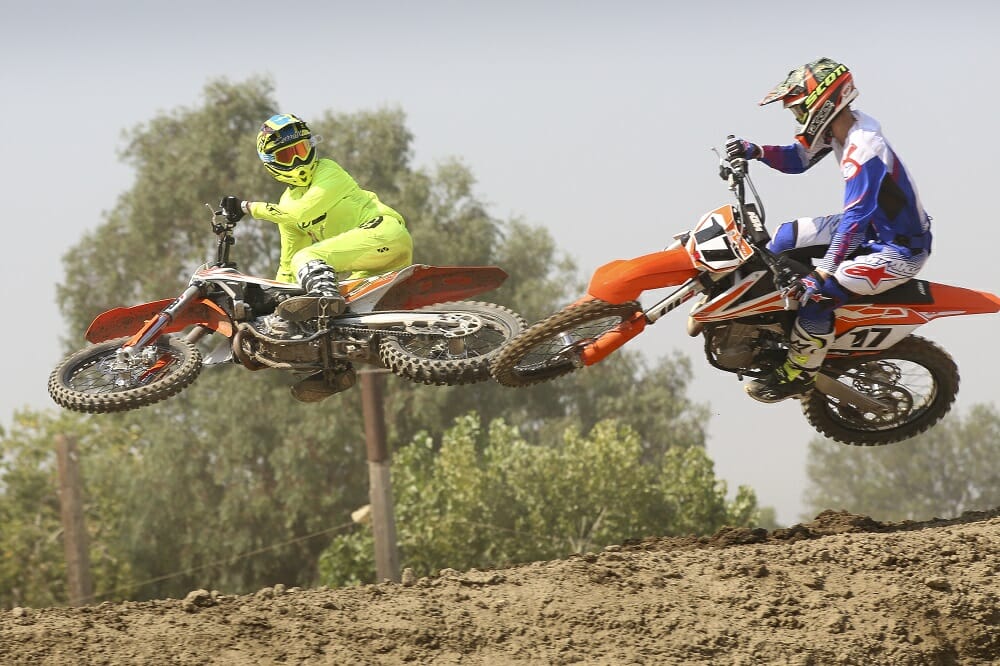 The 2017 KTM 450 SX-F and 350-F are on paper very similar, but on the track they are very different—different but good in their own way.
The 2017 KTM 450 SX-F and 350-F are on paper very similar, but on the track they are very different—different but good in their own way.
Earlier this year Cycle News tested the easy-on-the-eyes 2016.5 KTM 450 SX-F Factory Edition (you can read the test by clicking HERE) and was impressed with the bike, which a lot had to do with its light weight, user-friendly power and solid handling, so we came into this test with high expectations for the 450. Same with the 350.
Again, the major change that separated the 2016.5 Factory Edition from the 2016 450 SX-F was the addition of the WP AER 48 air fork. And, as the past has proven without fail, the KTM Factory Editions are a crystal-ball vision into what the next model year will feature, meaning the 2017 KTM 450 SX-F no longer uses the 4CS fork. It now comes standard with the 3.5-pound-lighter WP AER 48 air fork. The KTM 450 SX-F was already the lightest production 450 on the market and now it weighs approximately 224 pounds. As a reference, that’s about a whooping 15-pounds lighter than a Suzuki RM-Z450.
So, do the revisions KTM made before going to production on the 2017 450 SX-F make a noticeable improvement? Yes.
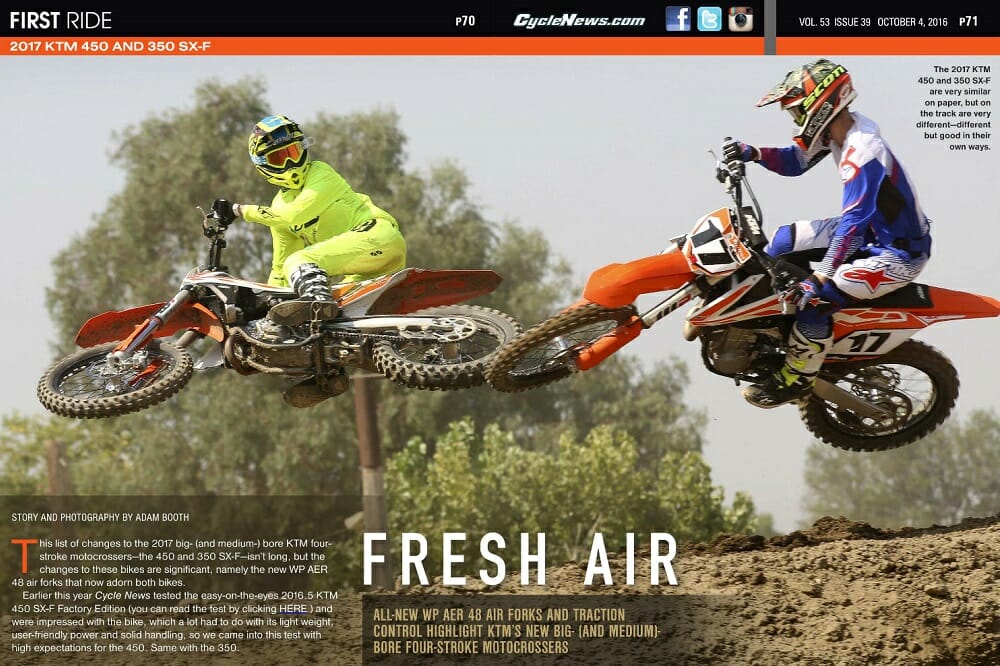
To read this in Cycle News Digital Edition, click HERE
Photography by Adam Booth
Aside from a completely new fork design, the tweaks and changes to the 2017 KTM 450 SX-F aren’t radical, but they do add to an already great package. New handlebar mounts (one-piece solid top) and a redesigned top triple clamp dial in added stiffness on every 2017 KTM. The outer fork-tube thickness decreased 1mm (from the AER 48 that came on the 2016.5 Factory Edition) for increased flex in the fork. This reduction of 1mm of thickness also knocked off a little more weight to the already light AER 48 fork.
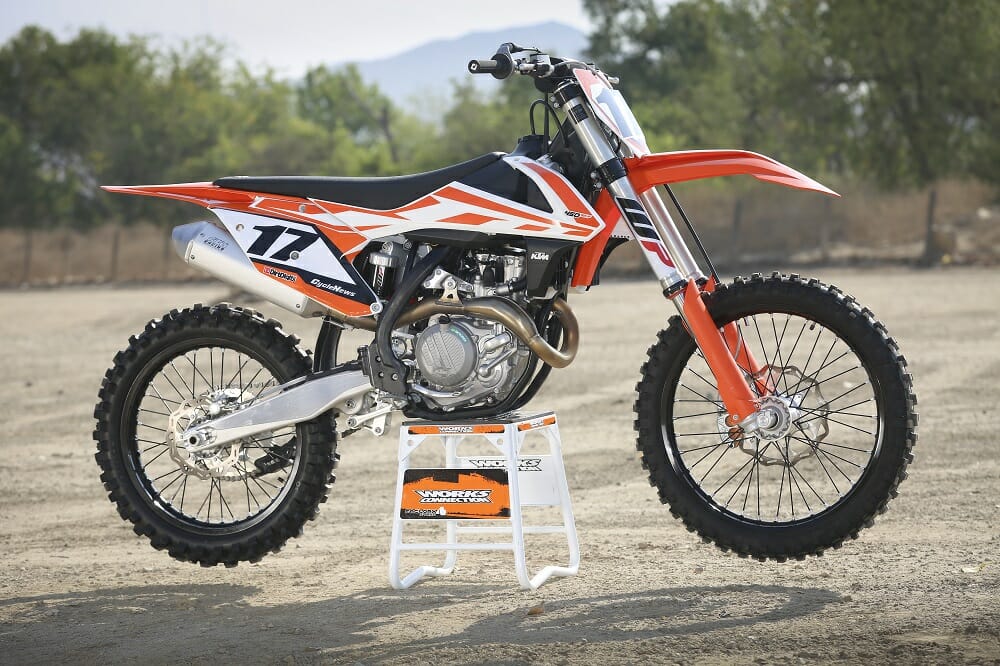 The already light 450 SX-F got even lighter for 2017.
The already light 450 SX-F got even lighter for 2017.
Valving in the AER 48 fork is also revised with a different internal piston. Out back, revised valving and a new shock spring—down one rate to 4.5 n/mm—helps boast overall balance of the bike. The aluminum head stays (a.k.a. upper engine mounts) are more rigid and 60-grams lighter than last year’s steel head. When it comes to engine performance, the base map is revised and all KTM four-strokes come with a new map switch/controller, featuring two maps, stock and aggressive, plus a button to engage traction control. An hour meter is now standard equipment, rims are Excel, and the brake pedal is 5mm longer, while the rear-pad material is less aggressive for better modulation.
Lovable Power
Any 250F rider (or any rider for that matter) who is intimidated by 450s should go ahead and give the KTM a try; this bike is far from mean and scary. It is what you want it to be, a gentle giant in the horsepower department. This doesn’t mean the KTM 450 SX-F is slow, just the opposite, it has an ultra friendly bottom-end pull, then it ramps into big power through the mid, then keeps going into a rev-limiter other 450s only dream of.
It delivers impressive power in a very predictable and usable method, equaling forward drive. Carving corners on the KTM is effortless thanks to the wide powerband. The 450 SX-F FE never wants to unexpectedly explode and break traction at inopportune times. Explosive, on/off power is only good for upsetting the chassis and locking up the suspension.
New for 2017 is the map switch/controller on the handlebar. We bounced between stock and aggressive depending on the track surface and how much forward thrust we really needed. The traction control (which is a new feature) is an acquired taste and not for every rider. Our testers who come from 250F backgrounds liked the traction control, especially as the track dried out, while our dedicated 450 guys gave it a whirl but chose to leave it off unless the tracks were blue groove and crazy slippery. In general, though they seemed to think that the traction control on the 450 can definitely be an asset at times and is well worth having. They didn’t think it was as big as an advantage with the 350 but was still worthy on ultra-dry and slipper tracks. Bottom line, we’re glad KTM added traction control to the 350 and 450. It’s a great idea.
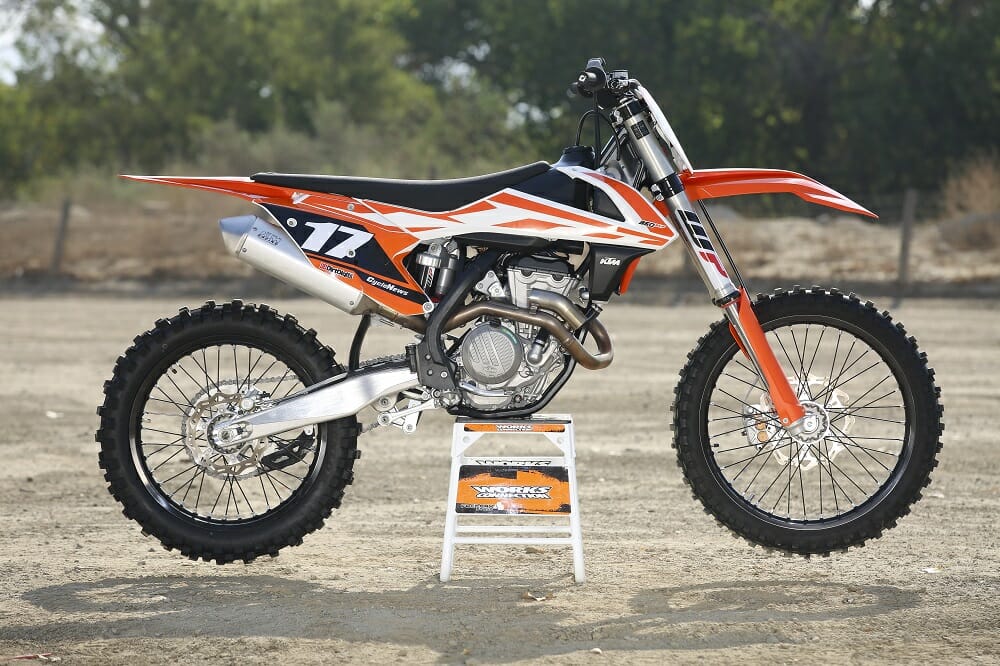 The 350 got all of the same changes as the 450.
The 350 got all of the same changes as the 450.
Hitting Bumps And Jumps
Since riding and testing the 450 SX-F Factory Edition, we’ve spent a good amount of time with the AER 48 fork on both KTMs and Husqvarnas. We have to come to like it a lot, especially when compared to the WP 4CS fork it replaces. The WP AER 48 air fork is a split-function design. The damping leg (right) is where you find the compression adjuster on top with rebound adjustment on the bottom. The left leg holds the air, which acts as a spring. The air spring is encapsulated and isolated from the fork seal so even if the fork seal leaks, the air-spring pressure isn’t affected. We know this because we had a fork-seal leak on the air side on one set and performance wasn’t affected. The standard setting for the 450 SX-F is 157 psi (10.8 bar) and is a great starting point. The benefit to the AER 48 design is the ease of use and adjustment.
As we’ve said before, the WP AER 48 air fork is without a doubt the best production air fork available. It is leaps and bounds better than the 4CS it replaces and is on par with many standard non-air spring forks. Even Honda has ditched air forks on their 450 for 2017, returning to a traditional spring fork, hearing the complaints of the consumers.
The first few inches of travel on the AER 48 is plush, much better than any other air fork and feels like a well set-up spring fork when compared to any other air fork. The AER 48 holds up in the stroke nicely while absorbing small bumps and chop, both under braking and acceleration. The AER 48 provides a progressive and predictable feel through the mid stroke. The 4CS fork had a tendency to bottom easily while the AER 48 offers good bottoming resistance. All the way through the stroke the AER 48 is smooth without any harshness. It also has the benefit of incredible front-end traction and they work as a fork is designed. Every tester was very impressed. The ability to easily adjust pressure depending on the track conditions and rider weight is a key feature of the air fork.
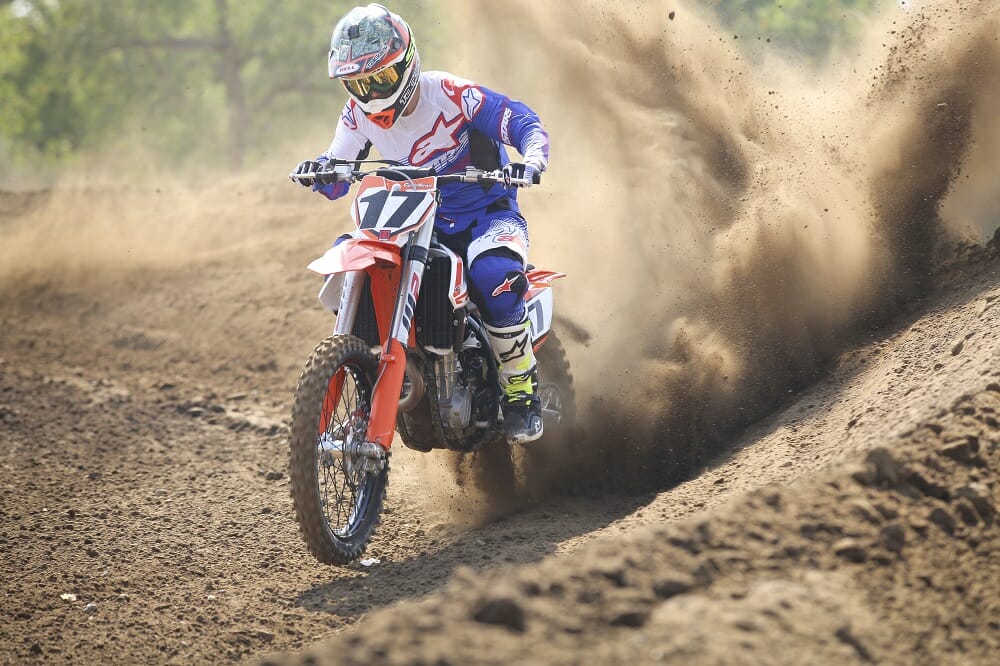 Now with WP AER 48 air forks, traction control and softer rear-shock spring, the 450 tips the scales at and amazing 224 pounds.
Now with WP AER 48 air forks, traction control and softer rear-shock spring, the 450 tips the scales at and amazing 224 pounds.
The overall balance of the 2017 KTM 450 SX-F is slightly improved thanks to revisions to the fork and a softer shock spring. We aren’t saying the 2016.5 450 SX-F was unbalanced, it wasn’t, but the 2017 450 SX-F is improved in that department. Hammering into braking bumps never resulted in a twitchy front end or the back end stepping out unexpectedly. Predictable is the key descriptive word when explaining the KTMs handling. The softer rear shock spring and internal revisions might border on too soft for very fast bigger riders, those pushing the 200-pound mark. For the average rider, the shock works well and provides great rear-wheel traction. We hovered around 105mm of sag for best overall balance.
The suspension changes for 2017 are an improvement over the 2016.5 Factory Edition and massive amounts better than the 2016 450 SX-F. The bike handles great through the loamy sand, over the hard pack, rails any type of corner and is light and easy to throw around. It’s safe to say the all-new 2017 KTM 450 SX-F is much improved over the 2016.
Nimble And Light
It is pretty amazing that a production 450 with electric start can weigh as little as the 2017 KTM 450 SX-F. It borders on crazy. That lack of weight is instantly felt out on the track. Throwing around the 450 SX-F feels like riding a 250F on nitrous. Thanks to the overall lightweight, initiating direction change is easy and the smooth power delivery provides awesome traction in any condition. The updated chassis in 2016 provided more stability, and, now with the addition of the AER 48 fork and revised shock settings, the 2017 KTM 450 SX-F is impressively stable, especially for a bike that is at the top of the class when it comes to cornering prowess.
Every element of the KTM450 SX-F ties together to create an excellent 450 motocross machine. The engine character, mated with a predictable chassis and good suspension makes it a fun and competitive race bike. It is the lightest production 450 motocross machine and it has electric start. The past five years has seen the KTM 450 SX-F evolve into an ultra-light, nimble handling and efficient motocross machine.
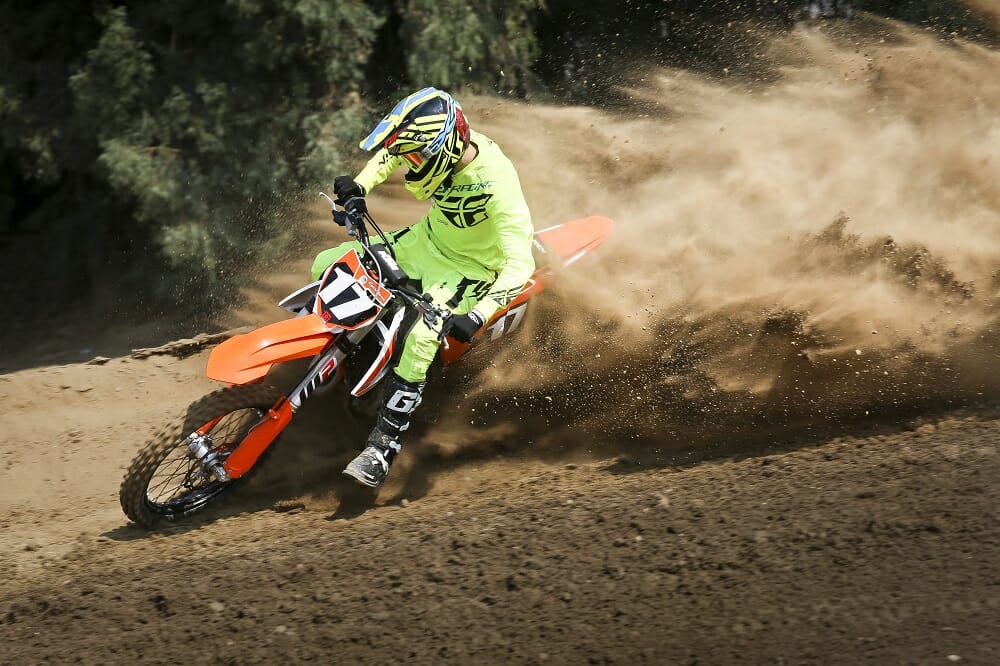 With the AER 48 air forks, small bump absorption is awesome, bottoming out is controlled, in-between is smooth and solid. It also has the benefit of incredible front-end traction
With the AER 48 air forks, small bump absorption is awesome, bottoming out is controlled, in-between is smooth and solid. It also has the benefit of incredible front-end traction
Comparing Oranges to Smaller Oranges
While spending time testing the 2017 450 SX-F we simultaneously tested the 2017 KTM 350 SX-F, riding the bikes back to back. There isn’t a Factory Edition 350 SX-F, but to make things pretty darn simple, the 2017 KTM 350 SX-F is nearly identical to the 450 SX-F. All the updates and changes to the 2017 KTM 450 SX-F apply to the 2017 KTM 350 SX-F. In fact, the suspension settings and the engine are all that separate the two bikes. The 350 motor is based off the 250 SX-F engine, making it slightly lighter than the 450 engine and bit heavier than the 250 SX-F. If you were blindfolded and sat on each bike, (on a stand with the engine off, because riding with a blindfold is dangerous) you wouldn’t be able to tell which is which. The 350 SX-F uses the exact same WP AER 48 fork with slightly different internal settings. Recommended air pressure is 10.6 bar (154 psi). The 350’s shock spring is also softer by one rate for 2017 (4.2n/mm) and softer than the 450’s shock spring.
Same But Different
Feel out on the track is much different between the 450 and 350. They are two completely different animals, in a good way. On most tracks, minus a deep sand track or a track like Glen Helen with horsepower-robbing uphills, the 350 is perfectly capable of hanging with and turning faster lap times than a 450. Riding the 350 requires a more aggressive 250F-style of riding and revving to beat out a 450, but nothing a 250F rider won’t appreciate and love. The 350 SX-F doesn’t hit the rev-limiter until 13,400 rpm. Every test rider leaned toward wanting to ride and race the 350 SX-F over the 450 SX-F, commenting that over the course of a moto they would have more energy aboard the 350. The 350 SX-F is slightly plusher overall due to different suspension settings.
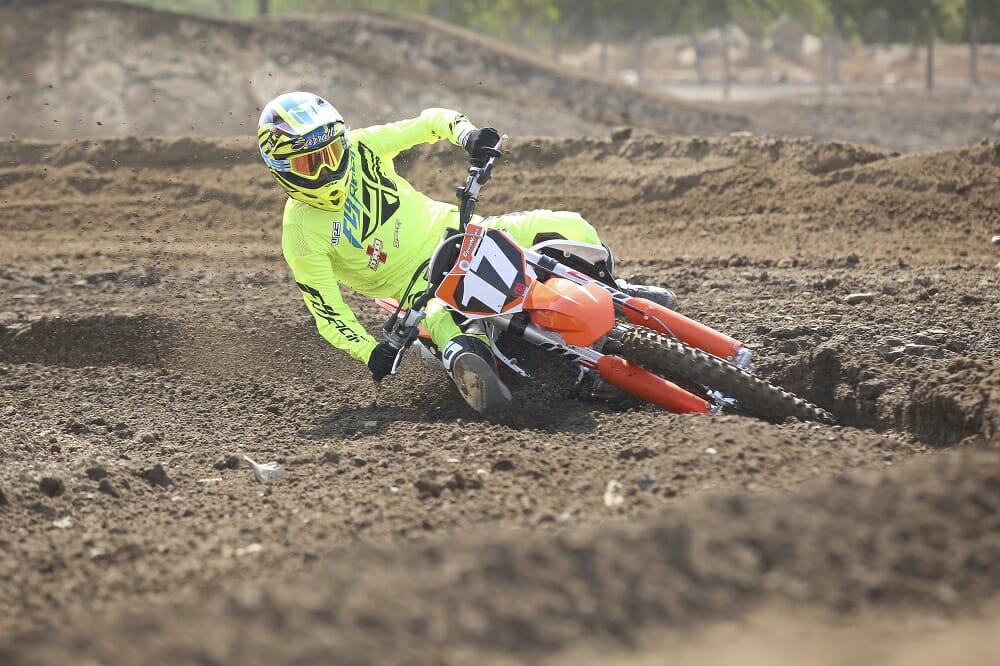 If you’re look for a fantastic all-around motocross bike, the 2017 KTM 350 SX-F is hard to beat.
If you’re look for a fantastic all-around motocross bike, the 2017 KTM 350 SX-F is hard to beat.
Our testers loved how light the 350 felt and mentioned repeatedly how nicely it dropped into corners. The crazy thing is that the 350 SX-F and the 450 SX-F are almost the same weight on the scale. The difference in handling and feel are all based on rotating mass in the engine and what 100ccs of extra power delivery does to the flex properties of the chassis. Creating even more of an aggressive feel to the 350 engine is the use of a standard six-spring clutch. The 450 uses the DPS clutch, providing a slightly softer engagement.
When the 350 SX-F first hit the motocross world, it was fun and different, helping bolster appeal. A strong following realized the purpose and potential of the smaller engine.
Now in 2017 KTM has created a 350cc engine that is faster than anyone could have imagined. The KTM 350 SX-F pumps out numbers that don’t give anything up to 450s from other manufacturers, making the lighter and more flickable feel very appealing to a lot of riders, especially those under 200 pounds and for riders who aren’t racing at a professional level.
Ultimate vet bike? Quite possible the ultimate motocross bike in general! CN

|
SPECIFICATIONS: 2017 KTM 450 SX-F / 350 SX-F
|
|
Engine
|
Liquid-cooled, SOHC, 4-stroke, 4-valve, single
|
|
Displacement
|
449cc / 349.7cc
|
|
Bore x Stroke
|
95mm x 63.4mm / 88.0mm x 57.5mm
|
|
Compression Ratio
|
12.6:1 / 14.0:1
|
|
Fuel Delivery
|
Fuel-injection, Keihin
|
|
Clutch
|
Wet multi-plate, Brembo hydraulic
|
|
Transmission
|
Five-speed
|
|
Final Drive Gearing
|
13/48 / 14/50
|
|
Front Suspension
|
WP AER 48mm air fork, compression and rebound damping adjustment;
11.8 in. travel
|
|
Rear Suspension
|
WP Monoshock with linkage, low-speed and high-speed compression damping, rebound damping and adjustable spring preload; 12.9 in. travel
|
|
Front Brake
|
260mm disc, double-piston caliper
|
|
Rear Brake
|
220mm disc, single-piston caliper
|
|
Handlebar
|
Neken
|
|
Tires
|
Dunlop Geomax MX32 80/100-21, 120/90-19
|
|
Weight
|
222 lbs. (without fuel) / 220 lbs. (without fuel)
|
|
Wheelbase
|
58.5 in.
|
|
Ground Clearance
|
14.6 in.
|
|
Seat Height
|
37.8 in.
|
|
Fuel Capacity
|
1.9 gal.
|
|
MSRP
|
$9399 / $9199
|
GEAR ID’d (Yellow Gear)
Gearset: Fly LE MEC Lite Hydrogen
Helmet: Fly F2 Carbon MIPS Retrospec Peick Replica
Goggles: EKS Brand
Boots: Gaerne SG-12
GEAR ID’d (Red/White/Blue Gear)
Gearset: Alpinestar Techstar
Helmet: Bell Moto-9 Carbon Flex
Goggles: SCOTT Prospect
Boots: Alpinestars Tech 10
To read this in Cycle News Digital Edition, click HERE
For more Cycle News Motocross motorcycle reviews, click HERE.
For more KTM motorcycle reviews, click HERE.